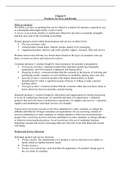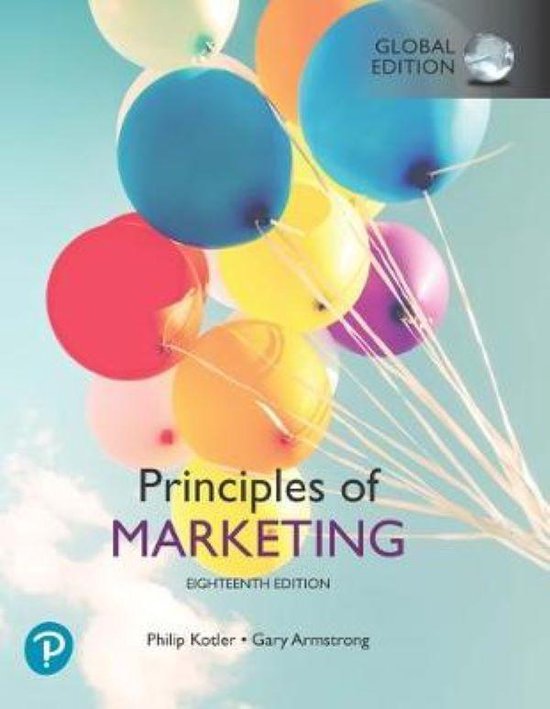Chapter 8
Products, Services, and Brands
What is a product?
We define a product as anything that can be offered to a market for attention, acquisition, use,
or consumption that might satisfy a want or need.
A service is an activity, benefit, or satisfaction offered for sale that is essentially intangible
and does not result in the ownership of anything.
Product planners need to think about products and services on three levels:
The core customer value
Actual product: brand name, features, design, quality level, packaging
Augmented product: delivery and credit, product support, warranty, after-sale service.
Products and services fall into two broad classes based on the types of consumers who use
them: consumer products and industrial products
Consumer products (= product bought by final consumers for personal consumption):
Convenience product: consumer product that customers usually buy frequently,
immediately, and with minimal comparison and buying effort.
Shopping products: consumer product that the customer in the process of selecting and
purchasing usually compares on such attributes as suitability, quality, price and style.
Specialty product: consumer product with unique characteristics or brand
identification for which a significant group of buyers is willing to make a special
purchase effort.
Unsought product: consumer product that the consumer either does not know about or
knows about but does not normally consider buying.
Industrial products (= product bought by individuals and organizations for further processing
or to use in conducting a business): (1) materials and parts, (2) capital items = industrial
products that aid in the buyer’s production or operations, (3) supplies and services = operation
supplies and maintenance and repair services, for example.
Organization marketing consists of activities undertaken to create, maintain, or change the
attitudes and behavior of target consumers an organization. Person marketing consists of
activities undertaken to create, maintain, or change attitudes or behavior toward particular
people. Place marketing involves activities undertaken to create, maintain, or change attitudes
or behavior toward particular places. Social marketing is the use of traditional business
marketing concepts and tools to encourage behaviors that will create individual and societal
well-being.
Product and Service Decisions
Individual product and service decisions:
Product quality: the characteristics of a product or service that bear on its ability to
satisfy stated or implied customer needs.
Product features
Product style and design: style describes the appearance of a product, design goes to
the very heart of a product.
, Branding: name, term, sign, symbol or design or a combination of these that identifies
the products or services of one seller or group of sellers and differentiates them from
those of competitors.
Packaging: activities of designing and producing the container or wrapper for a
product.
Product support services
A product line is a group of products that are closely related because they function in a similar
manner, are sold to the same customer groups, are marketed through the same types of outlets,
or fall within given price ranges.
A company can expand its product line in two ways: (1) line filling, which involves adding
more items within the present range of the line, or (2) line stretching, when a company
lengthens its product line beyond its current range.
A product mix (or product portfolio): the set of all product lines and items that a particular
seller offers for sale. Product mix width refers to the number of different product lines the
company carries. Product mix length refers to the total number of items a company carries
within its product lines. Product line depth refers to the number of versions offered of each
product in the line. The consistency of the product mix refers to how closely related the
various product lines are in end use, production requirements, distribution channels, or some
other way.
Services Marketing
Service intangibility mean that services cannot be seen, tasted, felt, heard, or smelled before
they are bought.
Service inseparability means that services are produced and consumed at the same time and
cannot be separated from their providers.
Service variability means that the quality of services may vary greatly depending on who
provides them and when, where, and how they are provided.
Services perishability means that services cannot be stored for later sale or use.
Service profit chain: the chain that links service firm profits with employee and customer
satisfaction. It consists of five links: (1) internal service quality, (2) satisfied and productive
service employees, (3) greater service value, (4) satisfied and loyal customers, (5) healthy
service profits and growth.
Internal marketing: orienting and motivating customer-contact employees and supporting
service employees to work as a team to provide customer satisfaction.
Interactive marketing: training service employees in the fine art of interacting with customers
to satisfy their needs.
Service companies face three major marketing tasks: they want to increase their service
differentiation, service quality, and service productivity.
Branding strategy: Building strong Brands
A powerful brand has high brand equity. Brand equity is the differential effect that knowing
the brand name has on customer response to the product or its marketing. positive brand
equity derives from consumer feelings about and connections with a brand. A brand with high
brand equity is a very valuable asset. Brand value is the total financial value of a brand.





